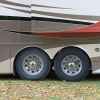
Why Do Some RVs Have 2 VIN Numbers?
No matter what you drive, your car, truck, or RV has a Vehicle Identification Number. It’s a long combination of letters and numbers that highlight where the vehicle was built, when it rolled off the line, and other information. But certain RVs come with not one, but two VIN numbers. But why would one vehicle need two identification numbers?

Why do certain Motorhomes come with two VIN numbers?
The answer lies in how certain RVs are built. On the one hand, there are motorhome companies that design and build their own motorhomes from the ground up. And on the other, there are companies that buy a truck and frame only to build the motorhome around it. This happens rather frequently in your C Class RVs, which have Ford or GM products as the base vehicle. Class B camper vans, on the other hand, will likely have just one VIN, since you aren’t coachbuilding a separate shell, just stuffing things inside.
These two VIN numbers will be scattered all throughout the RV, but there are certain places you should look. The most common place to find the RV for the truck is on the front of the engine, as well as inside the door pillars. On the other hand, the VIN from the RV manufacturer, however, is often found right in front of the driver, under the windscreen.
This manufacturer’s VIN is known as the Finished Unit VIN according to PopYatch. This is the VIN number you’ll use to title and register your RV, not the truck platform. And there’s a very easy way to decode the VIN number to make sure you’re using the right one.
How to decode RV VIN numbers

Decoding the VIN number of an RV is very similar to decoding the VIN of a regular automobile, though with slight differences. However, there’s only one thing you need to determine whether you’re looking at the motorhome’s VIN number or the truck’s. Just look at the first few letters.
If the base vehicle is, say, a Ford, then the second digit of the truck’s VIN number would be the letter F. For a General Motors product, such as Chevy, that letter would be G. The number or letter after that determines what division of the company and where they operate. And while any editor who reads this may wince, a complete and thorough list of manufacturer VIN numbers can be found on this Wikipedia page.
The same applies to RV VIN numbers. And the easiest way to make sure it’s not the truck platform VIN number is to make sure it doesn’t start with an F, G, or whichever letter is associated with the truck brand. From there, identifying an RV VIN is just like a car.
We skipped over the first letter, but that describes the country in which your particular RV was built. Digits four through nine will explain the size of the RV, the classification, and the engine inside it. Then there’s the check code, a standard on VIN numbers to ensure the code is legitimate. And lastly, there’s the serial number. This can help determine where it was manufactured, and when it rolled off the line. That said, the last digit of the VIN number will always represent the RV model year (though not necessarily the truck model year).
Common motorized RVs with two VIN numbers

The two big players in motorized RVs that use outsourced trucks are Gulfstream and Coachman. Gulfstream relies on the Ford F-Series line to power their motorhomes, while Gulfstream uses GM products. But motorized motorhomes aren’t the only vehicles, or even vessels, that have a VIN number.
If you’re using your personal truck to tow a trailer, that trailer has a vehicle identifiation number as well. But don’t worry, it’ll look fairly similar to the motorized RV VIN number.
There’s a lot of bureaucracy involved with registering vehicles, and with two VIN numbers, things get a bit complicated. But hopefully, this little guide has shined some light on how to differentiate the two-vehicle identification numbers. Just do your research, and look to your owner’s manual to make sure you register the RV under the correct VIN number.


